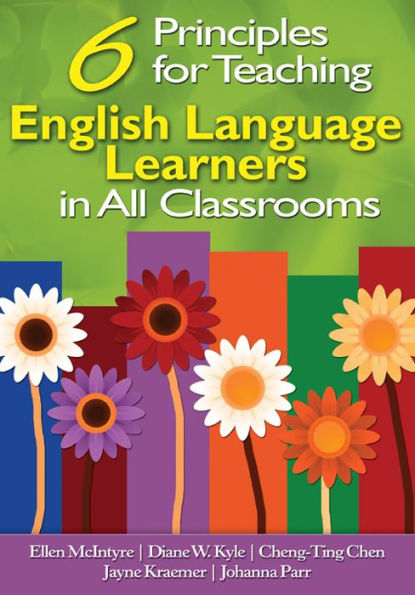
Six Principles for Teaching English Language Learners in All Classrooms
168
Six Principles for Teaching English Language Learners in All Classrooms
168eBook
Related collections and offers
Overview
"A highly accessible and practical resource for applying sociocultural theory to both pedagogy and parent involvement. It begins with theory, but then provides excellent examples of how the principles might be meaningfully applied in real classrooms."
—Robert Rueda, Professor
University of Southern California
Ensure high student achievement in diverse classrooms with this proven instructional model!
This vital resource presents educators with an instructional approach that is flexible and practical enough for mainstream classroom use—yet also academically rigorous and grounded in research on teaching English language learners (ELLs).
Ideal for elementary and middle school teachers as well as ELL specialists, this book offers six key principles to help educators address language development in a regular classroom while supporting ELL students in learning academic content. This field-tested model is based on five standards for pedagogy from the Center for Research on Education, Diversity, and Excellence (CREDE) as well as the authors′ sixth principle for family involvement. Focusing on one principle per chapter, this book includes:
- Lessons, tips, and in-depth vignettes from teachers who have been trained in the model
- Advice on working successfully with ELL families
- Guiding questions and self-assessments based on CREDE′s indicators for achievement of standards to help teachers monitor their own development
Six Principles for Teaching English Language Learners in All Classrooms will not only assist ELLs, but will ultimately benefit all learners in the inclusive classroom.

Product Details
| ISBN-13: | 9781452295329 |
|---|---|
| Publisher: | SAGE Publications |
| Publication date: | 07/17/2008 |
| Sold by: | Barnes & Noble |
| Format: | eBook |
| Pages: | 168 |
| File size: | 4 MB |
About the Author
Diane W. Kyle is a professor in the Department of Teaching and Learning at the University of Louisville. She has coauthored Reaching Out: A K–8 Resource for Connecting Schools and Families and Reflective Teaching for Student Empowerment: Elementary Curriculum and Methods, coedited Creating Nongraded Primary Classrooms: Teachers’ Stories and Lessons Learned, and published in such journals as Language Arts, Peabody Journal of Education, Journal of Education for Students Placed at Risk, Education&Equity, Teaching Children Mathematics, and Elementary School Journal. Her most recent project, codirected with Ellen McIntyre, is “Sheltered Instruction and Family Involvement: An Approach to Raising Achievement of LEP Students,” funded by the US Department of Education. She also codirected with Ellen McIntyre a research project, “Children’s Academic Development in Nongraded Primary Programs,” funded by the Center for Research on Education, Diversity, and Excellence (CREDE) at the University of California at Santa Cruz.
Table of Contents
1. IntroductionEnglish Language Learners of All Kinds
Language Learning: How Does It Happen?
BICS and CALP
All Teachers as Teachers of English Language Learners
A Look Back Is a Look Forward
Overview of the Book
Cast of Characters
A Note for Readers
2. Six Principles for Teaching English Language Learners: The Instructional Model
The CREDE Five Pedagogy Standards
The Model Enacted in Seventh Grade
Reflection on Cori′s Teaching
Cori and the CREDE Standards
Joint Productive Activity
Contextualization
Language and Literacy
Rigorous Curriculum
Instructional Conversation
This Seems Overwhelming: Can I Do It?
Scaffolding the Five Standards
3. Joint Productive Activity (JPA) and English Language Learners
Reflection on Vickie′s Lesson
Rationale/Definition of JPA
Is This JPA? Indicators of Joint Productive Activity
Classroom Culture
The Juggling Act: Grouping and Scheduling of JPA
Example of JPA in Study of Race and Racism
Reflection on Justin′s Teaching
JPA in Middle School ESL: Learning From Our Mistakes
Reflection on Jayne′s Teaching
Assessing JPA in Your Teaching
Teaching Tips for JPA
4. Contextualization and English Language Learners: Making Learning Meaningful
Reflection of Johanna′s Teaching
Meaning of Contextualization
Are We Connecting? Indicators of Contextualization
Examples of Contextualization
Contextualization in Middle School Language Arts
Contextualization in Kindergarten
Contextualization in Fourth-Grade Science and Mathematics
Reflection on Examples
Assessing Contextualization of Lessons
Teaching Tips
5. Language and Literacy for ELLs
Rationale/definition of Developing Language and Literacy
Indicators of Language and Literacy Teaching
The Case for Home Language Development
Reading Instruction and ELLs
Georgia′s Second Grade
Mary′s Fourth Grade
Writing in Middle School
Writing Across the Curriculum
Tips for Language and Literacy Teachers
Assessing Your Language and Literacy Teaching
6. Engaging Students With Rigorous Curriculum: High Expectations for English Language Students
Meaning of Rigorous Curriculum
Indicators of Rigorous Curriculum
Examples of Rigorous Curriculum
Rigorous Curriculum Enacted in Kindergarten
Rigorous Curriculum Enacted in Middle Grades Language Arts
Reflection on Examples
Questions to Guide Planning
Teaching Tips
Assessing Your Rigorous Curriculum
7. Instructional Conversation (IC)
Rationale and Definition of IC
How Does IC Differ From Traditional Teaching?
Beyond Discussion: Indicators of Instructional Conversation
Assistance Through Good Questioning
Think-Pair-Share Strategy
Examples of IC
Instructional Conversation in Middle School
Instructional Conversation With Young Children
Tips for Instructional Conversation
Assessing Your IC
8. Engaging Families of English Language Learners
Importance of Involving Families
Successful Ways to Involve Families of English Language Learners
Communicating With Families
Involving Families in Classrooms
Increasing Help at Home
Engaging Families in Workshops and Other School Events
Visiting in Students′ Homes
Challenges to Involving Families
Tips for Engaging Families
Assessing Your Family Involvement
9. Conclusion
Beyond a Model Approach
Compatible Views
Development of CREDE Standards
Preparation of Teachers and Teacher Educators
Concluding Remarks
References
Index
